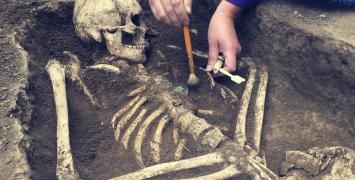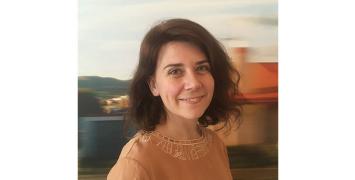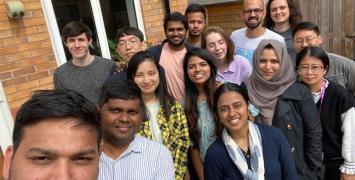
Researchers from anywhere in the world can apply for European Research Council grants, provided the research they undertake will be carried out in an EU Member State or Associated Country. But how and why would researchers from far flung countries hope to win ERC grants? Two Australian ERC Grant recipients share their experiences and motivation.
One very useful support for potential applicants from outside Europe is “EURAXESS – Researchers in Motion” - a European Union (EU) backed initiative supporting researcher mobility and career development, as well as enhancing scientific collaboration between Europe and the rest of the world. Here, EURAXESS’s Regional Representative for Australia and New Zealand, Mr Nishant Shandilya, interviews neuroscientist Prof. Seth Grant and sign language linguist Dr Adam Schembri.
Prof Seth Grant directs world-leading research at the Centre for Clinical Brian Sciences, University of Edinburgh. Over the last 25 years, his laboratory has made seminal contributions to understanding the roles played by synapses – the connections between each nerve cell – in learning, memory, and the mechanisms underlying innate and learned behaviours. This work has revealed how synapse dysfunction contributes to a wide range of developmental, neurodegenerative and psychiatric brain disorders of great social and economic importance, including schizophrenia, autism, depression, addiction and intellectual disability. His research has generated a wealth of freely available interdisciplinary datasets (proteomic, genetic, transcriptomic, electrophysiological, behavioural, synaptomic) and analysis tools for the neuroscience community. Prof Grant was awarded an ERC Advanced grant in 2015 |
Dr Adam Schembri is an Associate Professor in Linguistics in the Department of English Language and Linguistics at the University of Birmingham. He teaches modules on sociolinguistics, language and gesture and linguistic diversity. His research focuses on the linguistics of sign languages, especially Australian Sign Language (Auslan) and British Sign Language (BSL). He has published many journal articles and book chapters on sign language linguistics and is the co-author of the Cambridge University Press publication ‘Australian Sign Language (Auslan): An introduction to sign language linguistics’. Dr Schembri was awarded an ERC Advanced grant in 2020 |
Raised in Australia, you currently carry out research in the UK. What motivated you to move?
Prof. Seth Grant: My first experience in research was as an undergraduate in the Department of Physiology at the University of Sydney - and after finishing my medical degree I was offered a postdoctoral position at the Cold Spring Harbor Laboratory in the USA. This was a career-changing opportunity as this institute is at the forefront of molecular biology. After further postdoctoral research at Columbia University, which greatly fuelled my interest of neuroscience, I accepted an offer to start my own lab at the University of Edinburgh. Each of these moves expanded my experience into new fields, meeting enthusiastic people with inspiring new ideas.
I consider mobility to be a powerful way to expand and challenge one’s scientific thinking and I always encourage my graduate students and postdocs to move to new places.
Dr Adam Schembri: I moved to Europe for several reasons, but primarily because more colleagues were working in my field of research in this part of the world and being able to participate in a broader academic community offered more research opportunities. My career would not have been possible without the privilege of international mobility.
Opportunities would have been fewer if I had remained in Australia, so I have moved back and forth between Australia and the UK three times over the last two decades, pursuing opportunities in each country as they arose.
This mobility was also possible because the sign languages I work on – Auslan and British Sign Language – are historically related to each other, and the deaf communities in Australia and the UK have many links.
What made you decide to apply for an ERC grant? And how has it made a difference for you?
Prof Grant: I was attracted to ERC grants because they specifically encourage cutting-edge, pioneering projects. I admired this approach as it emboldens imaginative scientists to strike out in new directions. The ERC Advanced Grants have enabled me to pursue basic curiosity-led science, venturing in very productive new directions that many domestic funding agencies consider to be too risky.
Dr Schembri: I applied for an ERC grant because I had an idea for a high-risk, big-picture-question project that I hoped would make an essential contribution to the field of sign language linguistics. The ERC Advanced Grant scheme offered the possibility of sufficient funding to build a team of researchers to work on such a large-scale project. It will enable me to build such a team and hopefully provide new opportunities for deaf colleagues. Creating this team is incredibly important to me, as my research is not possible without collaboration with deaf researchers. In fact, without this support from the ERC, it would be impossible to achieve the research goals I set for myself at this stage in my career.
Can you describe your research in accessible terms?
Prof Grant: The overarching ambition of my research is to understand the molecular basis of behaviour. There must be fundamental organizing principles programmed by the genome that govern the behavioural repertoire of all animals. These are only now beginning to be understood. As a path toward elucidating these principles, my research has focussed on the proteins that are responsible for receiving signals from the outside world.
Studying these proteins in humans shows that damaging them causes over 100 developmental, psychiatric and neurological disorders. With the support of the ERC we have recently discovered that the distribution of these proteins across the brain reveals ‘synaptome maps’, which can store information and help explain why certain diseases cause behavioural changes at particular ages.
For more in-depth details of Prof Grant’s research, watch this interview:
Watching this video you are accepting Youtube cookies policy
Dr Schembri: My new SignMorph project aims to address two of the most fundamental questions in the language sciences: how much do the languages of the world resemble each other and how do they differ, and what factors account for both the cross-linguistic similarities and the differences? SignMorph will provide answers to these questions about the nature of human language through a focus on the sign languages of deaf communities.
The driving research question is: sign languages are natural languages, but what kind of languages are they? We aim to better understand similarities and differences in the grammar of sign languages, and how these are shaped by language-internal and language-external factors. The study of a distinctive combination of characteristics in sign languages means that this project will make a vital contribution to an understanding the human language capacity more generally.
For more details of Dr Schembri’s research, watch this interview:
Watching this video you are accepting Youtube cookies policy
What is it like to carry out research within an international environment?
Prof Grant: One of the great pleasures of working in an international environment is sharing ideas with bright and interesting people, no matter where they are from. My own lab has always been a highly diverse mix of people from different countries and cultures. I very much enjoy visiting institutions in different countries, discussing ideas and hearing about the challenges that other scientists face and that we sometimes take for granted.
Dr Schembri: As sign language research is highly specialised, the landscape is very international. Many PhD students and postdoctoral fellows travel away from their home country in search of opportunities that may not exist at home, as I did.
ERC funding will enable me to attract the necessary expertise without which the project would simply be impossible.
Do you and your original scientific community benefit from such international collaboration? Do you maintain research ties with institutions in Australia?
Prof Grant: Most definitely. EU collaborative projects and the ERC Advanced Grants have fostered far more international collaboration than any other funding agency that I have known. There is no doubt that the exchange of ideas through these collaborations has greatly expanded my own thinking and has enabled me to start new projects. I have an ongoing research collaboration at the Florey Institute of Neuroscience and Mental Health in Melbourne, which I very much enjoy. Like many expatriates, I like to support home institutions.
Dr Schembri: Yes, as a sign language researcher, I have always benefitted enormously from international collaboration, as we are a small highly specialised field. I continue to collaborate with colleagues in Australia.
Does being in Europe help build useful long-term links with colleagues in your field globally?
Prof Grant: Europe has a remarkably vibrant research environment, which benefits greatly from the diversity of researchers from the many ‘home’ countries, as well as the top-tier researchers that the international standing of European institutes and the excellence of European funding are able to attract from around the world. From within this environment I have established many long-term links that have proved extremely valuable as well as personally and intellectually rewarding.
Dr Schembri: Working in Europe helps with building links globally as there are more colleagues in my field working in this part of the world compared to Australia, and more opportunities to visit colleagues, accept invitations for talks, meet at conferences, etc, all of which are the basis for building collaborations.
You don’t have to win an ERC grant to work with an ERC funded research group!
The ERC signed two "Implementing arrangements" with Australian research funders to boost opportunities for scientists wishing to come to Europe to join research teams run by ERC grantees. Both the Australian Research Council (ARC) and the Australian National Health and Medical Research Council (NHMRC) provide opportunities for top Australian researchers to carry out such research visits
Would you encourage Australian or New Zealand researchers to consider joining ERC teams in Europe?
Prof Grant: I would strongly encourage Australian researchers to get involved in European scientific initiatives including the ERC’s grants. Science is a truly international endeavour and national boundaries and mentalities do nothing but hinder the advancement of knowledge. If you want to realise your full potential as a scientist you need to engage with, and be enriched by, the international community.
Dr Schembri: I definitely think that young researchers in Australia should consider applying for ERC Starting grants: they provide much more funding for a longer period than most available grants in Australia, enabling early career researchers to build their own team working on large scale project. The experience of working in Europe will also provide unique opportunities for Australians to learn about cultural differences in academia, to forge new collaborations, and to extend the international impact of their work.
Do you have any tips or advice for potential applicants from the southern hemisphere?
Prof Grant: Be bold, be critical and pursue the most important scientific questions you can think of.
Dr Schembri: I would suggest applicants find out as much information about ERC grants as they can by thoroughly familiarising themselves with all the available documentation, discuss their applications with EURAXESS in Australia, and ensure that they allow themselves as much time as possible to prepare the application.
Sharing the draft application with many other colleagues to ensure that maximum amount of feedback is also essential. I would also advise that they plan projects that extend their existing work into new areas, and focus on high-risk, big-picture research questions
EURAXESS Worldwide supports researchers who wish to connect or stay connected with Europe. In January 2020, the network was enlarged to include Australia and New Zealand. The hub’s office in Sydney supports researchers in the region who are interested in conducting research in Europe and promotes EU funded mobility opportunities, such as those linked to the ERC and Marie Skłodowska Curie Actions. The hub keeps researchers informed about career opportunities in Europe as well as international collaboration and networking possibilities. 15 webinars are planned for 2020 on various topics of interest to the local research community, in collaboration with EU Member States, scientific diasporas and academic institutions.





